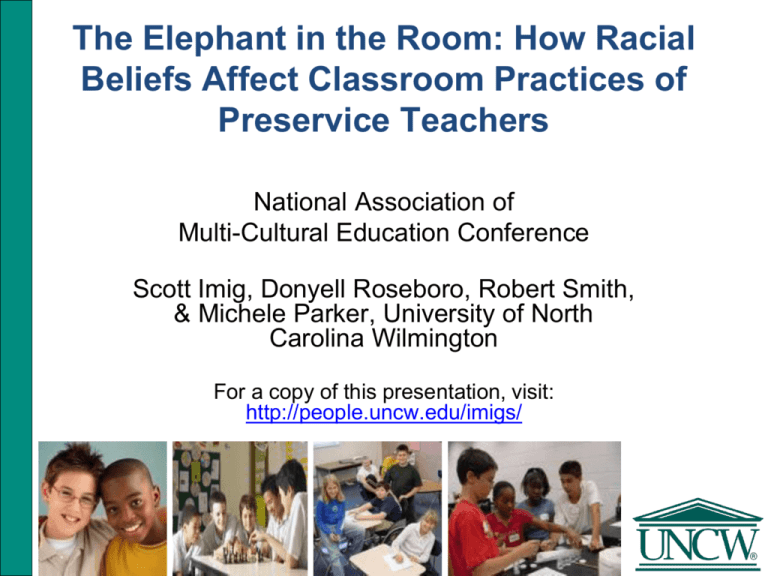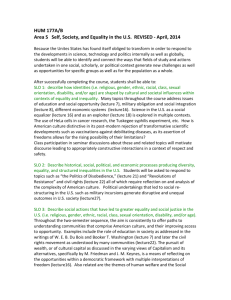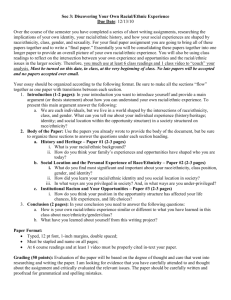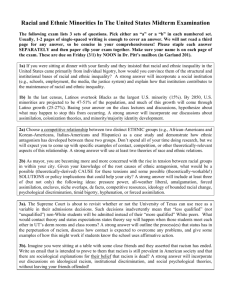The Development of Social-Justice Values in Pre
advertisement

The Elephant in the Room: How Racial Beliefs Affect Classroom Practices of Preservice Teachers National Association of Multi-Cultural Education Conference Scott Imig, Donyell Roseboro, Robert Smith, & Michele Parker, University of North Carolina Wilmington For a copy of this presentation, visit: http://people.uncw.edu/imigs/ Overview I. II. III. IV. V. Impetus for Our Work An Initial Survey and Results Current Project Findings and Implications Discussion Impetus for Our Work “I still feel uneasy about blacks and Mexicans. I treat them with respect and no differently than I would with anyone else; but there is still that hatred or dislike feeling that I have towards them.” – white female “My family and my experiences in school taught me to dislike and mistrust most black people. However, I always felt guilt and never hate.” – white female “Although I would not consider myself a racist, I am a bit prejudiced. I consider the majority of blacks to be loud, obnoxious and rude.” – white male “I had been taught growing up that we are different and it is best to be friends with those who are like you.” – white female “Though I’m not racist, I believe it is wrong to date someone of another race.” – white female Our Context • University of North Carolina Wilmington – Southern comprehensive, regional university – 11,800 students • • • • • • • • 10,700 undergraduate 58% female 85% Caucasian 5% African-American 3% Hispanic 2006 SAT Scores: 1150 Third most rigorous admissions standards in NC (public) Highest SES of any UNC Campus – Watson School of Education • 87% female & 88% Caucasian Teaching for Social Justice • Ana-Maria Villegas (2007) states, the “overriding goal of the social justice agenda in teacher education is to prepare teachers who can teach all students well, not just those traditionally well served by schools, so that as adults, all are able to participate in the economic and political life of the country.” • “teachers...have a moral and ethical responsibility to teach all their pupils, fairly and equitably.” Teaching for Social Justice “Challenging deficit perspectives and promoting affirming views of diverse students is a precursor to building teacher candidates’ disposition to teach all students equitably” (Villegas, 2007). We Know Teacher Dispositions Affect Student Learning and Classroom Teaching • Taylor and Wasicsko (2000) claimed that “there is a significant body of research indicating that teachers’ attitudes, values and beliefs about students…strongly influence the impact they will have on student learning and development” • “Dispositions are in the long run, more important than knowledge and skills” (Wilkerson, 2006). We Believe Teaching for Social Justice is the Right Thing to Do The Watson School of Education strives to ensure that all teacher candidates are prepared to teach a diverse student population from a multicultural and global perspective. We also strive to foster a culture of awareness and acceptance among our faculty and students that enables our students to understand the role of diversity and equity in the teaching and learning process.* Does this occur? *Watson School of Education Diversity Plan (2005) Initial Survey (Jan/Feb 2007) – An Attempt to Gauge Beliefs on Campus • 173 Incoming & Exiting UNCW students – 84% female, 90% white (Respondents) – 107 Teacher Education Students – 66 A&S Students • Ludlow, Enterline & Cochran-Smith (2008) Learning to Teach for Social Justice-Beliefs Scale • Attitudinal and behavior items generated from student work and current educational issues Highlights • Thinking about your current views on race, would you describe yourself as “not racist” 90 80 70 60 50 40 30 20 10 0 81.8 63.8 A&S Education "Not Racist" 100 90 80 70 60 50 40 30 20 10 0 73 65 A&S Education Appropriate • It is appropriate for individuals to date outside of their race “Agree” or “Strongly Agree” Highlights • Some racial/ethnic groups work harder than other racial/ethnic groups “Agree” or “Strongly Agree” – Ed. Students: 25.9% – A & S Students: 42.1% • Some racial/ethnic groups are naturally stronger students than other racial/ethnic groups “Agree” or “Strongly Agree” – Ed. Students: 30.6% – A & S Students: 34.5% • Issues related to racism and inequity should be openly discussed in the public school classroom – 57% of Ed. Students Agree/Strongly Agree • Part of the responsibilities of the teacher is to challenge school arrangements that maintain societal inequities. – 70% of Ed. Students Agree/Strongly Agree • Realistically, the job of a teacher is to prepare students for the lives they are likely to lead. – 62% of Ed. Students Agree/Strongly Agree What if Students Hold Certain Attitudes? Do they manifest themselves in classrooms? Our Pilot Study Social Justice Beliefs of Middle Grades Teacher Candidates Participants & Data 20 Middle Grades Interns Social Justice Inventory Core Developed by Ludlow and CochranSmith (2006) Interviews Classroom Practices of Teacher Candidates Participants & Data 5 Supervisors - 3 observations/student Cooperating Teacher - Summative Evaluation North Carolina Teacher Observation Rubric – Diversity Standard Academic Growth of Pupils Taught by Teacher Candidates Participants & Data 400 pupils in 20 Middle Grade classrooms Teacher Work Sample Methodology Schalock (1997) Instrumentation: Our 15-Item Survey • Boston College Social Justice Inventory – Sample Items: • An important part of learning to be a teacher is examining one's own attitudes and beliefs about race, class, gender, disabilities, and sexual orientation. • Issues related to racism and inequity should be openly discussed in the classroom. • Good teaching incorporates diverse cultures and experiences into classroom lessons and discussions. • It's reasonable for teachers to have lower classroom expectations for students who don't speak English as their first language. • Additional Items: • Some racial/ethnic groups work harder than other racial/ethnic groups • I would date someone of another race • Some racial/ethnic groups are naturally stronger students than other racial/ethnic groups • Scoring: • 1-5 response range per item • Minimum Score = 15 Maximum Score = 75 Instrumentation: North Carolina Observation Rubric* Standard 2: Teachers establish a respectful environment for a diverse population of students. – Teachers provide an environment in which each child has a positive, nurturing relationship with caring adults. – Teachers embrace diversity in the school community and in the world. – Teachers treat students as individuals. – Teachers adapt their teaching for the benefit of students with special needs. – Teachers work collaboratively with the families and significant adults in the lives of their students. *McCrel (2008) Sample Construct Teachers embrace diversity in the school community and in the world. Teachers demonstrate their knowledge of the history of diverse cultures and their role in shaping global issues. They actively select materials and develop lessons that counteract stereotypes and incorporate histories and contributions of all cultures. Teachers recognize the influence of race, ethnicity, gender, religion, and other aspects of culture on a student’s development and personality. Teachers strive to understand how a student’s culture and background may influence his or her school performance. Teachers consider and incorporate different points of view in their instruction. Very Weak (1) Weak (2) Fair (3) Demonstrates a lack of knowledge of diverse cultures, their histories, and their roles in shaping global issues Frequently displays knowledge of diverse cultures, their histories, and their roles in shaping global issues. Does not understand the influence of race, ethnicity, gender, religion, socioeconomics, and culture on students’ development and attitudes. Acknowledges the influence of race, ethnicity, gender, religion, socio-economics, and culture on a students’ development and attitudes. Good (4) Excellent (5) Promotes a deep understanding of cultures through the integration of culturally sensitive materials and ideas throughout the curriculum. Capitalizes on diversity as an asset in the classroom. Instrumentation: Teacher Work Sample Methodology • Interns complete an assessment assignment (TWS) – pre and post test of content knowledge with results reported by subgroup • Interns have to analyze the results identifying factors that may have affected student or student subgroup performance Participants • Demographics (n=20): – Gender: • 60% female 40% male – Race: • 80% Caucasian • 10% Hispanic 15% African-American – Age: • 60% (18-25) • 10% (36-45) 20% (26-35) 10% (46+) – Concentration: • 40% Math • 10% Science 40% Social Studies 10% English Findings • Social Justice Scores – Range: 45 – 64 – Mean: 55 – SD: 5.47 Findings • There was a statistically significant (r=.67, p=.009) relationship between teacher candidate social justice score and classroom behaviors Embracing Diversity 5 Classroom Behavior Score 4.8 4.6 4.4 4.2 4 Embracing Diversity 3.8 3.6 3.4 3.2 3 45 50 55 Social Justice Score 60 65 Interview Guide Sample Questions • How do you define diversity? • How do you define race? • How do you define yourself racially? (White, Black, Multiracial, etc.) • How have you come to an understanding of race?—discuss the ways in which you have come to personally define yourself with regard to race and the ways in which others have defined or talked about race with you. Qualitative Data Coding Process • Grounded Theory (Strauss & Corbin, 1990) • Four Step Process – Open Coding – Axial Coding – Selective Coding – Memoing Chunking Codes • Open Codes: 59 initial codes identified • Axial Coding: 4 primary codes identified – Knowing – Processing/Learning – Teaching/Creating – Being P rep arat ion Evo lving Judging Hat re d Com mun it y Bigot ry Op in ion s St ra t egies Lov e Fear Civic Obligat io n T ea chin g/Creat ing T ea mwork Com fort able Emo t io na l Role swit chin g Un der t he radar Colo rblin d Acc ept in g Con scien ce Being Back gro und An cest ry Et hics T ea che r c an didat e be lie fs P roc essing/ Learn ing Forgiv in g Con sciousne ss Values T rav eling M orals Hist ory Cult ure Forge t t in g T alk in g St ruggling Reme mberin g T h in kin g Kn owing Exp erien ces Collect iv e Family Differen ce Frie nds In dividua l Dive rgen t f rom t h e no rm Ot h er t han ma in st ream Un ique Selective Coding From analysis of the interviews, one selective code was identified which describes teacher candidates’ understanding of the relationship between race and education. Teaching as a matter of consciousness and conscience. Consciousness: How do we come to “know” race? Awareness of institutional racism (e.g., One intern questioned the standards of behavior in schools and whether they are “white” standards. A second criticized why the school they were placed at for internship would not teach African American history). – Bubble sheets categorize people into races; these questions matter: “I have filled out enough sheets to tell me that I am Caucasian.” – “Then I came into the education program and…I was made aware of it…and you have to be conscious of it.” Conscience: How do we teach for social justice? • Relevant concepts: – Emotions: hatred, bigotry, respect, love – Civic obligation, morals, values, ethics • “I guess, my morals. I’ve been taught to accept all people…and again, taking classes here at UNCW, they’ve taught us not to discriminate” • “You think that if you love them enough, it won’t matter” • “I need to help them be good citizens” Interview Data: How do teacher candidates’ consciousness and conscience relate to their pupils’ academic achievement? “I saw a lot with my minority students especially in this one class and they were like, “Oh well, it doesn’t matter I’m going to make a bad grade anyway.” …But because of that they didn’t take advantage of it and a lot of it just has to do with that they don’t care and I tried to help them and guide them through this…I mean I can’t make them want to do it.” Interview Data: Pupil achievement (cont’d) “There was a huge achievement gap between whites, blacks and Hispanics. The only explanation that I could come up with is that maybe with Hispanic students it was an ESL thing, but when I divided them, ESL and Hispanic, it was still the same, still low in both categories. I really, I don’t know the difference. It’s challenging.” What does this mean? • What does this tell us about the Middle Grades program at the Watson School of Education in relation to diversity? • Are we preparing teachers who can effectively teach students of color? Limitations of Pilot Study • Sample size • Low number of students of color in some middle school classrooms • Variation related to differences in subjects taught by intern • Lack of control of the assessments conducted by interns • Lack of common training for university supervisor and partnership teachers in the use of NC diversity standard to evaluate interns Next Steps We plan to expand this study to the Elementary Education program at WSE – 200-230 student teachers/year Use Structural Equation Modeling – – test the causal relationships between teacher attitudes, behavior, and student achievement students as the unit of analysis (N = 400) What is your reaction? Questions? References: Ludlow, L. H., Enterline, S., & Cochran-Smith, M. (2008). Learning to Teach for Social Justice-Beliefs scale: An application of Rasch measurement principles. Measurement and Evaluation in Counseling and Development, 20, 194-214. McCrel (2008). North Carolina Teacher Evaluation Process. Denver, CO. Millman, J. (Ed.). (1997). Grading teachers, grading schools. Is student achievement a valid evaluation measure? Thousand Oaks, CA Corwin Press, Inc. Schalock, M.. D. (1998). Accountability, student learning, and the preparation and licensure of teachers: Oregon's teacher work sample methodology. Journal of Personnel Evaluation in Education, 12(3), 269285. Taylor, R., & Wasicsko, M. (2000). The dispositions to teach. Retrieved November, 10th2008, from www.education.eku.edu-Dean-The http://www.education.eku.edu-Dean-The Dispositions to Teach.pdf. Villegas, A. M. (2007). Dispositions in Teacher Education: A Look At Social Justice <http://jte.sagepub.com/cgi/content/abstract/58/5/370> . Journal of Teacher Education, Vol. 58, No. 5, 370-380 Wilkerson, J. R. (2006). Measuring teacher dispositions: Standards based or morality based? Teachers College Record. Retrieved October 10, 2008 from http://www.tcrecord.org WSE Diversity Plan (2005). Retrieved October 12, 2008 from http://www.uncwil.edu/ed/pdfs/WSEDiversityPlan.pdf Thank You • Scott Imig, Donyell Roseboro, Robert Smith, & Michele Parker, University of North Carolina Wilmington • For a copy of this presentation, visit: http://people.uncw.edu/imigs/








